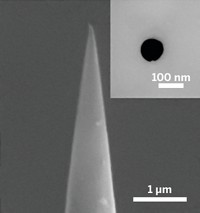Advertisement
Grab your lab coat. Let's get started
Welcome!
Welcome!
Create an account below to get 6 C&EN articles per month, receive newsletters and more - all free.
It seems this is your first time logging in online. Please enter the following information to continue.
As an ACS member you automatically get access to this site. All we need is few more details to create your reading experience.
Not you? Sign in with a different account.
Not you? Sign in with a different account.
ERROR 1
ERROR 1
ERROR 2
ERROR 2
ERROR 2
ERROR 2
ERROR 2
Password and Confirm password must match.
If you have an ACS member number, please enter it here so we can link this account to your membership. (optional)
ERROR 2
ACS values your privacy. By submitting your information, you are gaining access to C&EN and subscribing to our weekly newsletter. We use the information you provide to make your reading experience better, and we will never sell your data to third party members.
Analytical Chemistry
New Pipette Picks Up Single Cells
Device will simplify isolation of individual cells for biochemical examination
by Laura Howes
July 29, 2014

Researchers are keen to profile individual cells, particularly cancer cells because they can have different genetics and respond to drugs differently. But isolating single cells can be a tricky business. That’s what Lidong Qin’s group at the Houston Methodist Research Institute found when they began collaborating with cancer genetics experts. So, when the team couldn’t find an easy technique, they developed one instead, creating a handheld pipette that catches single cells and releases them in submicroliter droplets (J. Am. Chem. Soc. 2014, DOI: 10.1021/ja5053279).
Current techniques, explains Qin, require considerable skill or are expensive to use. For example, manual manipulation of single cells often still relies on using mouth pipettes, whereas high-throughput methods typically require costly fluorescence-activated cell sorting instruments.
Qin’s group used their microfluidics expertise to develop a new approach instead, one that that takes inspiration from the standard micropipettes found in every biology and biochemical laboratory.
Their new pipette tip has a hook just large enough to catch a single cell and fits onto a customized pipette that has two channels filled with cell-free medium rather than air. One channel of the pipette is used to pull up a cell suspension into the tip and wash the trapped cell before positive pressure is applied to the other channel and the cell is released. The entire procedure takes just 10 seconds.
"I think this work presents a very fresh and neat method for manually manipulating single cells," says Huabing Yin, lecturer in biomedical engineering at the University of Glasgow.
Of course, at 10 seconds a cell, filling a 96-well plate with the new pipette is still time consuming. Qin hopes to speed things up by multiplexing the pipette. But for high-throughput techniques, Yin says, quicker techniques such as fluorescence-activated cell sorting will remain more appropriate.
The technique’s biggest benefit is how easy it is to learn, Qin says. “My high school student, Sharon Li, who had very minimum research training before joining my lab, was able to transfer single cells professionally.”




Join the conversation
Contact the reporter
Submit a Letter to the Editor for publication
Engage with us on Twitter